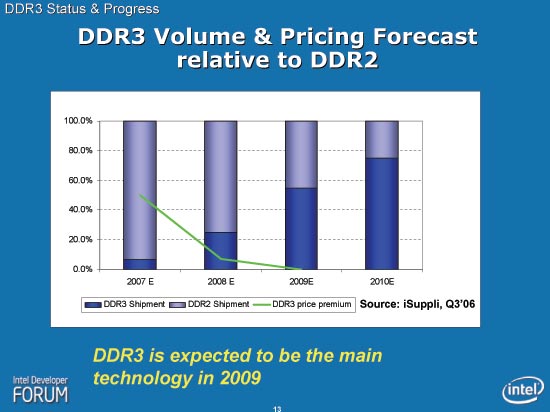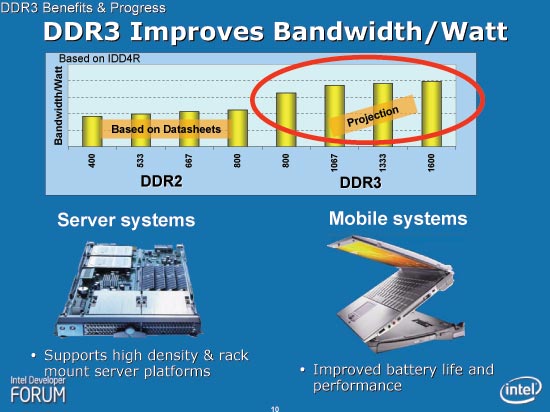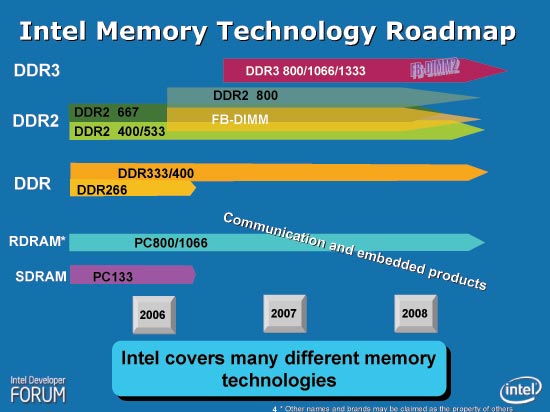IDF Fall 2006 - Day 2: Geneseo, Santa Rosa, Memory Roadmap and More
by Anand Lal Shimpi on September 28, 2006 3:43 AM EST- Posted in
- Trade Shows
Intel's Memory Roadmap
Yesterday we saw some early demonstrations of DDR3-1066 on Intel desktop platforms. DDR3 will be introduced with the new Bearlake family of chipsets in 2007, and will begin a slow and steady ramp much like DDR2 did on 915.

At launch, Intel is forecasting a 60% price premium for DDR3 over DDR2, but by the end of 2008 is expecting that premium to drop to below 10%. Although the transition is starting in 2007, DDR3 won't become mainstream until 2009 based on the data Intel shared with us.

Without being able to look at AMD's memory roadmap, it's difficult to say whether or not we will have a dual-technology memory market again with the transition to DDR3. Chances are that AMD will choose to stay with DDR2 until 2008 at the earliest, especially given DDR3's price premium in 2007. AMD has always been more practical/user focused with its technology decisions, while Intel tends to focus on the long term and driving the industry towards new technologies. We need both approaches to keep prices low and to actually move technology forward, although it can seem frustrating at times.

With regards to FB-DIMMs, Intel was quick to shoot down reports of the technology's early demise. The second version of FB-DIMM will be available alongside DDR3 memories and Intel will continue to use the technology until 2009 at the earliest. Intel's memory roadmap after 2009 is unclear, but FB-DIMMs will be used for at least that long - still only in the high end workstation/server markets.










7 Comments
View All Comments
porkster - Thursday, September 28, 2006 - link
If you ask me, laptop graphics is a major issue at the moment.Intel really needs to bring forth the Santa Rosa chipset to set a new bench level for gfx. x3000 maybe just enough to move upto, but even the power of the gfx intergrations, isn't that great.
Vista will make most laptop's second generation, the day it is released.
johnsonx - Thursday, September 28, 2006 - link
It's been speculated that AMD would have something to show in a hotel room across the street from IDF as they have in past years. So far it seems AMD is silent this year. A bad sign? AMD not as close on quad-core and/or K8-L as everyone has been hoping?What's the industry scuttlebutt on this?
smitty3268 - Thursday, September 28, 2006 - link
I was wondering the same thing. Perhaps K8L won't actually be any faster than current Conroes?fitten - Thursday, September 28, 2006 - link
You know... as much as people say this, it's odd that the aging FSB architecture is in the fastest system on the market right now... even faster than "newer" non-FSB architecture. Sure, it may not post as high synthetic benchmark bandwidth and latency numbers but when running applications, it sure seems to do pretty well. Sure, a new interconnect architecture might make it even faster and cooler but simply because the FSB is "aging" doesn't necessarily imply that it doesn't work.
Xenoterranos - Thursday, September 28, 2006 - link
While I agree with your point, at the crux of the argument is the question about when FSB will be too out dated. We all know it doesn't scale that well, and it's a testament to Intel's engineering teams that they are able to make it work so well. On the Xeons we see them moving toward dual FSB's, considering that we now have dual core processors, maybe this isn't that bad of a sign for the good ol FSB. HyperTransport is making great strides, and I would love to see Intel direct some of it's considerable brainpower at (co?)developing a new system like that instead of finessing all the power they can out of the one they have. I think they really believe that FSB is the way to go right now, but I would seriously doubt they have no plans to move to something like HT in the future.fitten - Friday, September 29, 2006 - link
Intel's serial interconnect that they're working on is called CSI.Clauzii - Thursday, September 28, 2006 - link
I find it kind of funny to see Vista running on MAC OS ;)